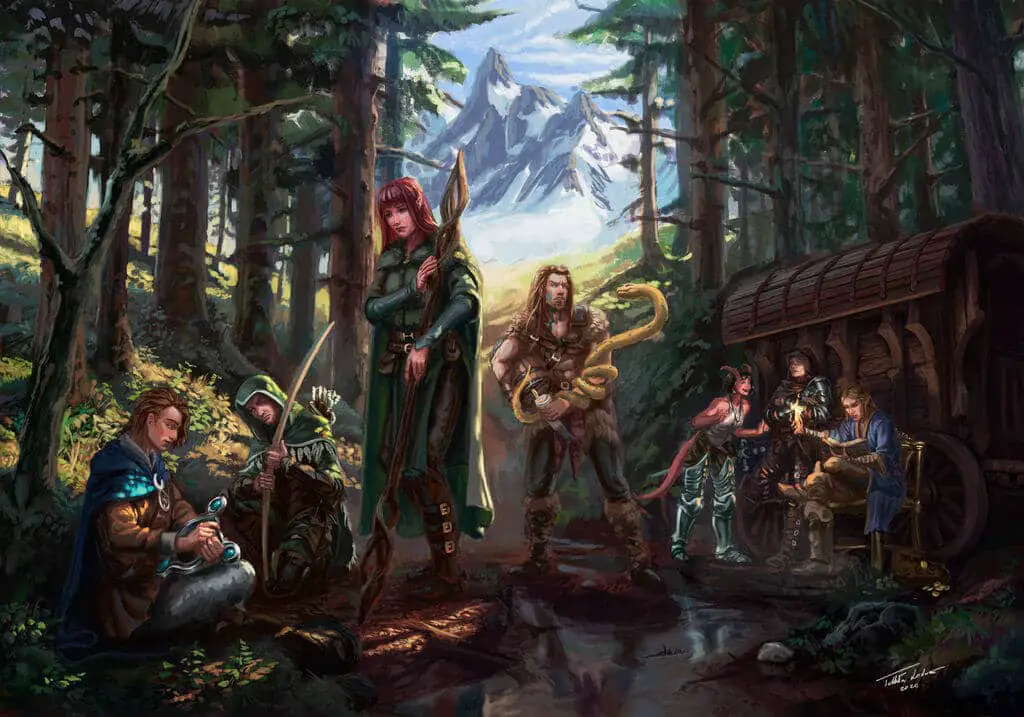Rune Knight Fighter D&D 5e subclass review featured image is a combination of imagery from Tasha’s Cauldron of Everything and a photo by Kurt Cotoaga. This article contains affiliate links to put gold in our coffers.
The Archetype of the Rune Knight Fighter was introduced in Tasha’s Cauldron of Everything. Like many of the subclasses from this book, it’s pretty strong!
In this review, we’ll have a closer look at the Rune Knight features and how these synergize with the Fighter’s main class features, then review suitable feat, race, and multiclass options and finally combine these into some build concepts.
As always, these are just my thoughts. If you have any other ideas about the Rune Knight, please let me know in the comments below!
Bonus Proficiencies – 3rd Level
Rune Knights harness the power of giants by carving Runes on their equipment. At 3rd level, you gain proficiency in Smith’s Tools and learn the giant language.
This is thematic and potentially opens the door to some roleplay opportunities.
Rune Carver – 3rd Level
You use magic Runes to enhance your gear. The language of this feature only ever says ‘you’ and ‘yours’, implying that you are the only one who can use your Rune-enhanced gear – your DM might be more permissive and allow you to share your gear with your party members.
You learn two Runes at your start, and you learn more as you level up (up to five in total). Runes can be traded out when you level up. You inscribe your Runes onto your gear at the end of a long rest. Each Rune has a passive effect that is always on and an active effect that can be used once per short rest.
There are 6 Runes to choose from, although two of them are only available from level 7 and up. The save DC is 8 + proficiency bonus + Constitution modifier.
Two Runes require a bonus action to invoke, two require a reaction, one requires a bonus action to start and a reaction to use each turn, and one can be triggered on a hit.
Reaction Runes
Cloud Rune
Passive: Advantage on Dexterity (Sleight of Hand) and Charisma (Deception) checks.
Active: If a creature within 30ft you can see (can be you) is hit by an attack roll, you can use your reaction to transfer the target of the attack to another creature within 30ft (other than the attacker) using the same roll.
This reaction is guaranteed to save one target from being hit – if at least two creatures are within range. This might have zero effect on the new target (which is great if the attack is shifted to another, tougher party member!). The passive effect is nice for rogues or tricky face characters.
Stone Rune
Passive: Advantage on Wisdom (Insight) checks and 120-foot darkvision.
Active: You can force any creature you can see that ends its turn within 30ft of you to take a Wisdom save or be charmed by you for up to a minute. While charmed, the target is incapacitated and has its speed set to zero. The target can repeat the save at the end of its turn.
This is a save or nothing effect – you might end up with no result at all. However, the final result is extremely impactful, making it worth the risk. The passives are really good, particularly if your character has no darkvision.
‘On Hit’ Rune
Fire Rune
Passive: Your proficiency bonus is doubled for any tool check.
Active: When you hit a creature with a weapon attack, you can invoke fiery shackles. These cause 2d6 fire damage, and a Strength save, or the target is restrained for 1 minute. While restrained, the target takes 2d6 fire damage at the start of its turn and can repeat the save at the end of its turn.
Always does a bit of damage, at least. This is very nice if the target fails its save, even once. Expertise in tools is useful if you have some proficiencies and your DM lets you use them for something interesting.
Bonus Action Runes
Frost Rune
Passive: Advantage on Wisdom (Animal Handling) and Charisma (Intimidation) checks.
Active: For 10 minutes, you gain a +2 bonus to Strength and Constitution checks and saves.
Both the passive and active effects are a little underwhelming. The active effect is nice for grappler builds (effectively increases your Strength score by +4) or if you have multiclassed to a spellcaster. Also useful for death saves (although those should be avoided if at all possible!).
This might be one of those to pick up early to help your grappling/shoving and swapping out later once you’ve picked up Athletics expertise from a feat or a multiclass.
This gets more useful if you multiclass with a spell casting class to help with concentration saves.
Hill Rune (7th Level or higher)
Passive: Advantage on poison saves and resistance to poison damage.
Active: You gain resistance to bludgeoning, slashing, and piercing damage for one minute.
Probably the best Rune for overall defenses. Both the passive and active effects are strong on a Fighter. This also synergizes with the Cloud Rune; you can redirect a nasty enemy attack to yourself, and even if it hits, only take half damage.
Unlike Barbarian Rage, you can cast spells and concentrate on them while using this ability.
Bonus Action and Reaction Rune
Storm Rune (7th Level or higher)
Passive: Advantage on Intelligence (Arcana) checks, and you can’t be surprised.
Active: Use a Bonus Action to see the future for one minute (or until incapacitated). When you or a creature you can see within sixty feet makes an attack roll, save, or ability checks, you can use your reaction to give that roll advantage or disadvantage.
This one is a little heavy on action economy however the active effects are amazing. This is the strongest Rune. It will contend a bit with your other reaction options, Runes and Runic Shield, so you need to keep an eye on that.
Giant’s Might – 3rd Level
As if you didn’t already get enough features at level three, you get yet another one!
As a bonus action, you can imbue yourself with the might of giants for up to 1 minute. You can use this ability proficiency bonus times per long rest. While imbued you:
- Become Large (unless there is insufficient space)
- Have advantage on Strength checks and saves
- Deal an extra 1d6 damage with a weapon attack or unarmed strike one per turn
Becoming Large is great; you can now grapple Huge creatures, and you will take up four squares on the battlefield, increasing the number of squares you can reach with your attacks (including attacks of opportunity). A party member can cast Enlarge on you, making you Huge.
This is such a fun ability. Who doesn’t want to play a Halfling or Goblin that grows Large a few times a day?
There seems to be some controversy about whether being increased in size also increases your weapon damage die.
- There is a rule for monsters in the Dungeon Master’s Guide that is behind this: “Big monsters typically wield oversized weapons that deal extra dice of damage on a hit. Double the weapon dice if the creature is Large, triple the weapon dice if it’s Huge, and quadruple the weapon dice if it’s Gargantuan.”
- I don’t think the intent is for this to apply to players, and I think the player character ‘equivalent’ of this is the 1d6 extra damage you get once per turn.
- If your DM does allow you to double up your damage dice, then I think the Rune Knight is overpowered and becomes easily the strongest fighter at level three.
Runic Shield + Additional Rune – 7th Level
You gain a new reaction, which forces a reroll of an attack roll made against another creature you can see within 30ft. You can use this reaction proficiency bonus times per long rest.
This is great for canceling out critical hits against your party members – although it can leave you with a choice to make if you also have the Cloud or Storm Runes available.
Great Stature + Additional Rune – 10th Level
Finally, a less powerful ability. You gain 3d4 inches in height permanently, and your Giant’s Might now does 1d8 extra damage (instead of 1d6).
You might end up forgetting you even have this feature.
Master of Runes + Additional Rune – 15th Level
You can now use your Runes twice per short rest instead of one. Given that you now have 5 Runes, you now get to use your Runes 10 times per short rest.
This is a huge power bump, and it’s at this level that the Rune Knight clearly becomes the most powerful Fighter subclass. The Battle Master maxes out at 6 dice per short rest, plus one per initiative roll if they have run out. The Rune Knight’s Runes are more impactful, you get more of them to use (10 per short rest), and on top of that, you’ve got your Giant’s Might, and Runic Shield uses (up to 12 of these per long rest as well!).
Runic Juggernaut – 18th Level
And you’re not even done! Your Giant’s Might damage now becomes a 1d10, and you can now make yourself Huge and increase your reach by five feet as well.
Rune Knight Subclass Summary
The Rune Knight has some of the most fun features of any Fighter subclass.
The base Fighter’s damage scales well to higher levels of play with the extra attacks that the Fighter gets. The Rune Knight adds some control to this, along with tactical and out-of-combat utility. It’s a bit of an all-rounder, which is unusual for a Fighter.
The Rune Knight is pretty front-loaded and also gets significant additional power bumps in higher tiers of play, making it, in my view, the strongest Fighter of all in tiers three and four.
The biggest issue with the Rune Knight is picking your moments to use your abilities. You only get to use each of your Runes once per short rest (at this level), and picking the right time can be tricky. This could potentially lead to ‘Rune paralysis’ where you end up not using your Runes because you’re always waiting for ‘just the right moment.’
Some of the features have a relatively short range (thirty feet). Being Large or Huge with bonuses to Strength checks (shove/grapple) seems to fit the idea of being a tank in the front lines a bit more than being a ranged archer. You don’t actually get all that many bonuses to damage, so the role that best seems to suit the Rune Knight is a melee tank, controlling enemies by shoving them prone and using your suite of defensive reactions to help out the party.
Feat Options
I’m assuming most Rune Knights will go for a Strength-based build.
Fighters get more ASIs and can potentially get more feats than any other class, so there’s tons of flexibility.
As always, Polearm Master and Great Weapon Master are a great combination for Strength-based melee Rune Knight. You should keep an eye on your bonus actions and reactions; you already have a ton of options for these, so you won’t get quite as much out of Polearm Master as usual, but using a reach weapon, while Large or Huge will give you enormous coverage of the battlefield. So Sentinel is also still an interesting option, even though the number of reactions you will now have available is nigh-on ridiculous.
While you can grapple, you can’t hit grappled creatures with a two-handed weapon, so you should just shove creatures prone using your advantage on Strength checks and Large/Huge size. This will give you a consistent source of advantage on your subsequent attacks to offset the -5 to hit of Great Weapon Master, allowing you to apply the +10 damage boost very frequently.
Skill Expert or Prodigy could provide expertise in Athletics for grapples without needing a multiclass dip.
Sharpshooter is always great for ranged builds and can be combined with Crossbow Expert for an extra bonus action attack and/or Piercer.
Race Options
Pretty much every race will work well with the Rune Knight. It doesn’t matter what size you start out with – you will still become Large when using Giant’s Might.
As always, Custom Lineage and Variant Human are great choices with yet another feat.
Multiclassing
One level of Rogue or Ranger could provide expertise in Athletics for shoves. Some of the passive Rune benefits synergize nicely with Rogue abilities – you could be a Huge burglar 😉
You get some of the main Barbarian features via Runes and Giants Might, so this is not as appealing as usual as a multiclass option.
You get some interesting features for a potential multiclass with Wizard, Cleric, or Druid, with a boost to concentration saves and advantage on Arcana and Insight checks. A Forge Domain Cleric seems like a match made in heaven for a Rune Knight.
Going for Unarmed Fighting and mixing in some Monk also sounds like a lot of fun.
Build Ideas
There are so many builds that will work out just fine with the Rune Knight.
A Dwarven Rune Knight multiclassed with Forge Domain Cleric, wielding a warhammer and shield, all seems wonderfully thematic.
A Goblin, Halfling or Kobold Rune Knight is just a ton of fun. Suddenly switching from small to large in combat feels amazing.
A Goliath grappler, using Unarmed Fighting and talking Skill Expert for expertise in Athletics.
Basically, anything will work, and work well.
Summary
That wraps up my review of the Rune Knight! In summary, it’s a powerful and fun subclass that starts strong and gets stronger as the game goes along.
Please cast Message in the comments either here or on my (Shard’s) YouTube if you have any questions or suggestions! You can find more content about D&D 5e Fighters here.





I love this subclass I played an orc rune knight fighter with 1 level of rogue and was a grappler. I have a new build idea that combines the warforged race along with rune Knight Fighter and Armorer Artificer.
It’s definitely a big hit with players since it was released! Many fun builds born form the Rune Knight.